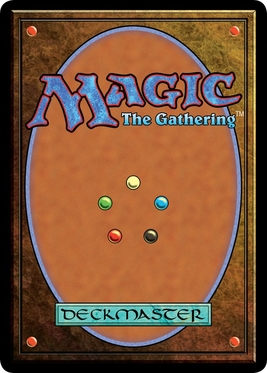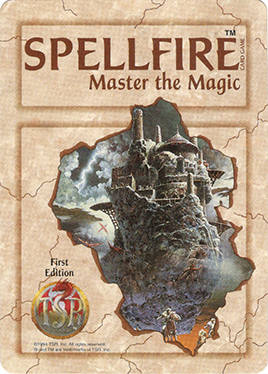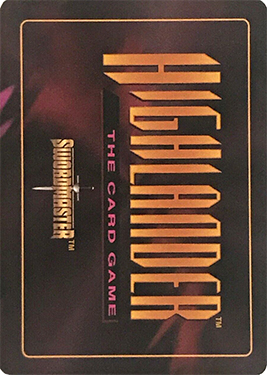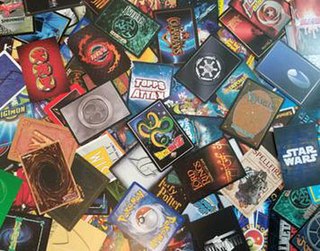
Magic: The Gathering is a tabletop and digital collectible card game created by Richard Garfield. Released in 1993 by Wizards of the Coast, Magic was the first trading card game and had approximately fifty million players as of February 2023. Over twenty billion Magic cards were produced in the period from 2008 to 2016, during which time it grew in popularity. As of the 2022 fiscal year, Magic generates over $1 billion in revenue annually.

Spellfire: Master the Magic is an out-of-print collectible card game (CCG) created by TSR, Inc. and based on their popular Dungeons & Dragons role playing game. The game appeared first in April 1994, shortly after the introduction of Magic: The Gathering, in the wake of the success enjoyed by trading card games. It was the second CCG to be released, preceding Wizards of the Coast's second CCG Jyhad by two months. More than one dozen expansions for the game were released, and the final expansion was released in October 1997.

The Babylon 5 Collectible Card Game is an out-of-print collectible card game set in the Babylon 5 universe. It was published from 1997 to 2000. The game is ideally set for 4-5 players but can be played with a minimum of two players up to as many as 20 if using multiple Non-Aligned Factions and Home Factions. This CCG is distinct from most others of the genre for being specifically designed to be played by more than two players. The gameplay tends to have strong political elements encouraging significant player interaction aka "table talk" which is appropriate for a game based on a series which featured such a strong element of political intrigue. During its six-year existence under the Precedence Entertainment banner it released two core sets, five expansions sets and one revision set. There were two World Championships during that time. The game still continues to have a cult following as further expansions were made available online.
Vampire: The Eternal Struggle is a multiplayer collectible card game published by Wizards of the Coast (1994-1996), then White Wolf Publishing (1996-2010) and after several years of hiatus, by Black Chantry Productions (2018-present). It is set in the World of Darkness and is based on the Vampire: The Masquerade roleplaying game.
The collectible card game Magic: The Gathering published seven expansion sets from 1993 to 1995, and one compilation set. These sets contained new cards that "expanded" on the base sets of Magic with their own mechanical theme and setting; these new cards could be played on their own, or mixed in with decks created from cards in the base sets. With Magic's runaway success, many of the printings of these early sets were too small to satisfy the rapidly growing fanbase. Cards from them became rare, hard to find, and expensive. It was not until Fallen Empires and Homelands that Wizards of the Coast was able to print enough cards to meet demand; additionally, Wizards of the Coast published Chronicles, a reprint set that helped fix many of the scarcity issues with the earliest sets.
Ice Age is a block of three expansion sets in Magic: The Gathering, consisting of the Ice Age, Alliances and Coldsnap sets. It is also the titular first set in the block. The Ice Age set is the eleventh set and the sixth expansion set, previewed at the Canadian Card and Comics Spectacular in early June 1995, and released later that month. Set in the years from 450 to 2934 AR, the set describes a world set in perpetual winter due to the events in Antiquities. Ice Age was followed up June 1996 with Alliances, the fourteenth Magic: The Gathering set and eighth expansion set.; and on July 21, 2006 with Coldsnap. The time period between Alliances and Coldsnap was the longest period of time between the beginning and the completion of a full block in Magic. Originally, the set Homelands, released in October 1995, was the second set in the Ice Age block, but following the release of Coldsnap, Homelands was removed from the block in favor of Coldsnap.
The collectible card game Magic: The Gathering published nine base sets from 1993–2007, also referred to as core sets. The base sets were considered descendants of the original Limited Edition, and shaped the default setting and feel of Magic. These sets consisted entirely of reprinted cards. These cards were generally simpler than cards in expansion sets, omitting multicolored cards, and used only the original abilities and keywords of Magic such as Flying and Trample. This simplicity led to many cards from these sets being considered "staples" of deck design. All cards were given a white border to mark them as reprints, with a few exceptions. From Fourth Edition in 1995 onward, a new base set would come out once per two years in the spring or early summer; for tournament play, that set would be legal for two years in the Standard format until the next core set replaced it.
Portal is the name given to the three Magic: The Gathering starter level sets. The original Portal was released on May 1, 1997, followed by Portal Second Age on June 24, 1998 and Portal Three Kingdoms on July 6, 1999. The Portal set was inspired by Chinese mythology; Three Kingdoms in particular by the 14th century Chinese historical novel Romance of the Three Kingdoms by Luo Guanzhong.
The collectible card game Magic: The Gathering has released compilation sets, reprint sets, and box sets over its history. These are distinct from core sets and expansion sets, the most heavily marketed sources of new cards. With the exception of Chronicles, reprint sets generally do not affect tournament legality in supported formats; for example, cards reprinted in the Modern Masters reprint set, while legal for tournament play, did not necessarily cause the card to be included in the "Standard" environment.

On The Edge is an out-of-print collectible card game released in 1994, not long after Magic: The Gathering. The setting and characters were based on the RPG titled Over the Edge. The game's story was set on an island in the southern Mediterranean called Al Amarja, where various factions were fighting for control.
Magic: The Gathering formats are various ways in which the Magic: The Gathering collectible card game can be played. Each format provides rules for deck construction and gameplay, with many confining the pool of permitted cards to those released in a specified group of Magic card sets. The Wizards Play Network, the governing body that oversees official Magic competitive play, categorizes its tournament formats into Constructed and Limited. Additionally, there are many casual formats with the Commander format being one of the most popular formats of the game.

Galactic Empires is an out-of-print collectible card game with a science fiction theme. It was published by Companion Games in 1994 until the company's bankruptcy in 1997.
Masters Edition is a series of Magic: The Gathering expansions that have been released exclusively for Magic: The Gathering Online. Each set consists of reprints from early Magic sets that had yet to be released to Magic Online. To date, four incarnations of Master's Edition, as well as a spinoff have been released:

Highlander: The Card Game is a collectible card game based on the Highlander franchise of films and television series. It was released in March 1995. The original set had 165 cards sold in 16-card booster packs.
The rules of Magic: The Gathering were originally developed by the game's creator, Richard Garfield, and accompanied the first version of the game in 1993. The rules of Magic have been changed frequently over the years by the manufacturer, Wizards of the Coast, mostly in minor ways. However, major rules overhauls have also been done a few times.

A collectible card game (CCG), also called a trading card game (TCG) among other names, is a type of card game that mixes strategic deck building elements with features of trading cards. It was introduced with Magic: The Gathering in 1993.

The BattleTech Trading Card Game is an out-of-print collectible card game (CCG) set in the BattleTech universe. The game was developed by Wizards of the Coast (WotC) for FASA and released in 1996. It went out of print after its last expansion, Crusade, in 1998.
The Rath Cycle is a cycle of three Magic: The Gathering expansions that continues the events of the Weatherlight Saga. Whereas there had previously been no official term for a trilogy of thematically or story-linked expansions, starter decks and booster packs from all three of these sets had the phrase "The Rath cycle" printed on them, firmly establishing "cycle" as the official word of choice and "The Rath Cycle" as the name of this particular cycle. It consists of Tempest, Stronghold and Exodus as the 20th, 21st and 22nd expansion sets, respectively.

The Masquerade Cycle, sometimes incorrectly referred to as the "Masques block", is a Magic: The Gathering cycle that is set on the planes of Mercadia, Rath, and plane of Dominaria. It consists of the expansion sets Mercadian Masques, Nemesis, and Prophecy. Mercadian Masques was the first set that is not subject to the Wizards of the Coast Reprint Policy, meaning that none of its cards appear on its Reserved List.










